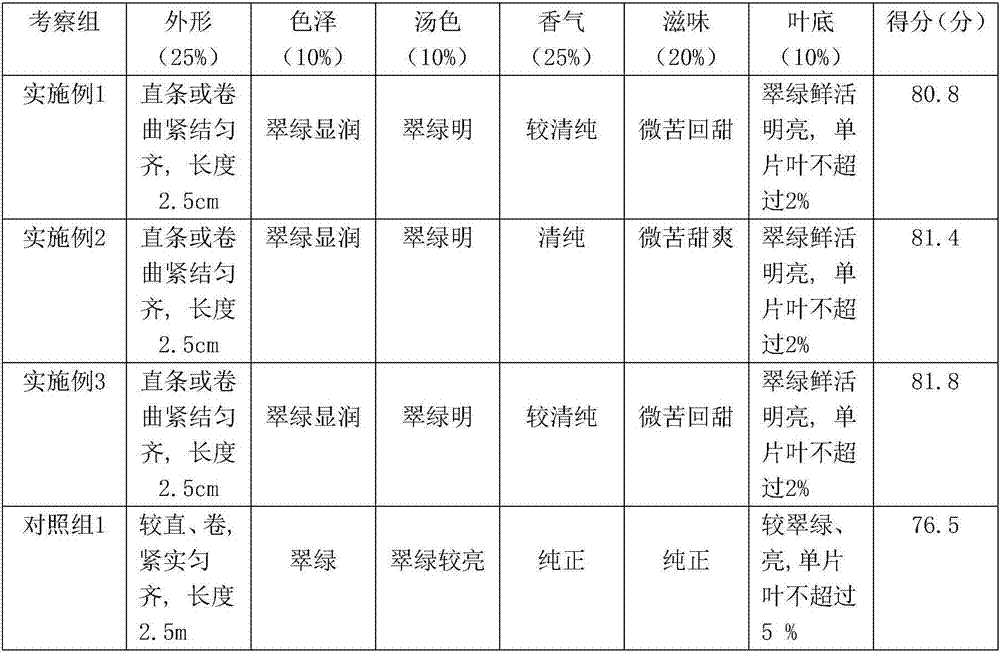Deep processing method of small-leaf Kuding tea
A small-leaf Kuding tea and deep processing technology, applied in the field of tea processing, can solve the problems of inconsistent quality of small-leaf Kuding tea, unfavorable market development and promotion, etc., and achieve the effects of good batch reproducibility, pure aroma, and green leaf bottom.
- Summary
- Abstract
- Description
- Claims
- Application Information
AI Technical Summary
Problems solved by technology
Method used
Image
Examples
Embodiment 1
[0027] Embodiment 1: the method for the deep processing of lobular Kudingcha:
[0028] (1) Picking: Pick small-leaf Kuding tea locally grown in Guizhou as raw material, and pick it from April to May. Picking starts when the buds and leaves grow to one bud and one to two leaves. The picking length is 2.5cm. For leaves, insect-damaged leaves and single leaves, it is best not to collect rain leaves and dew leaves, and use bamboo baskets to store them in order to prevent fresh leaves from turning red or getting stuffy;
[0029] (2) Cleaning of fresh leaves: use aqueous solution containing 3% sodium chloride to soak and wash the fresh tea leaves, and after 6 minutes, spread them evenly on a bamboo dustpan and drain;
[0030] (3) Withering: put the tea leaves drained in step (2) in a ventilated withering tank, evenly spread the tea leaves, and after nitrogen protection, adjust the temperature to 35°C, wither for 80 minutes, and let cool to room temperature under nitrogen protection ...
Embodiment 2
[0035] Embodiment 2: the method for the deep processing of lobular Kudingcha:
[0036] (1) Picking: Pick small-leaf Kuding tea locally grown in Guizhou as raw material, and pick it from April to May. Picking starts when the buds and leaves grow to one bud and one to two leaves. The picking length is 2.5cm. For leaves, insect-damaged leaves and single leaves, it is best not to collect rain leaves and dew leaves, and use bamboo baskets to store them in order to prevent fresh leaves from turning red or getting stuffy.
[0037] (2) Use an aqueous solution containing 5% sodium chloride, soak and wash fresh tea leaves, and after 7 minutes, spread them evenly on a bamboo dustpan and drain.
[0038] (3) Finishing: put the withered tea leaves into the roller fixing machine, the amount of tea leaves should be 3 / 10 of the volume of the cylinder, and the temperature is controlled by the program to perform the finishing operation. 3 minutes, then control the temperature to 55°C, and the d...
Embodiment 3
[0042] Embodiment 3: the method for the deep processing of lobular Kudingcha:
[0043](1) Picking: Pick small-leaf Kuding tea locally grown in Guizhou as raw material, and pick it from April to May. Picking starts when the buds and leaves grow to one bud and one to two leaves. The picking length is 3.0cm. For leaves, insect-damaged leaves and single leaves, it is best not to collect rain leaves and dew leaves, and use bamboo baskets to store them in order to prevent fresh leaves from turning red or getting stuffy;
[0044] (2) Cleaning of fresh leaves: use aqueous solution containing 7% sodium chloride to soak and wash fresh tea leaves, and after 6-8 minutes, spread them evenly on a bamboo dustpan and drain;
[0045] (3) Withering: Put the tea leaves drained in step (2) into a ventilated withering tank, evenly spread the tea leaves, and after nitrogen protection, adjust the temperature to 40°C, wither for 100 minutes, and let cool to room temperature under nitrogen protection ...
PUM
 Login to View More
Login to View More Abstract
Description
Claims
Application Information
 Login to View More
Login to View More - R&D
- Intellectual Property
- Life Sciences
- Materials
- Tech Scout
- Unparalleled Data Quality
- Higher Quality Content
- 60% Fewer Hallucinations
Browse by: Latest US Patents, China's latest patents, Technical Efficacy Thesaurus, Application Domain, Technology Topic, Popular Technical Reports.
© 2025 PatSnap. All rights reserved.Legal|Privacy policy|Modern Slavery Act Transparency Statement|Sitemap|About US| Contact US: help@patsnap.com

